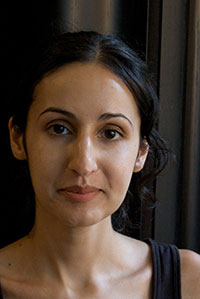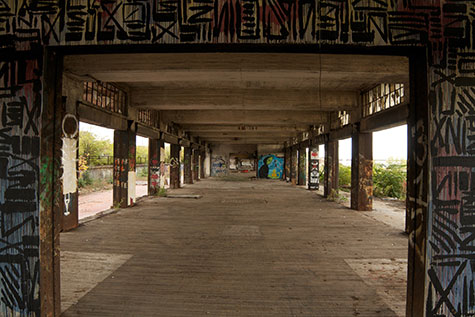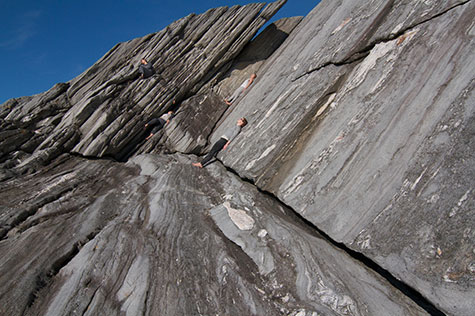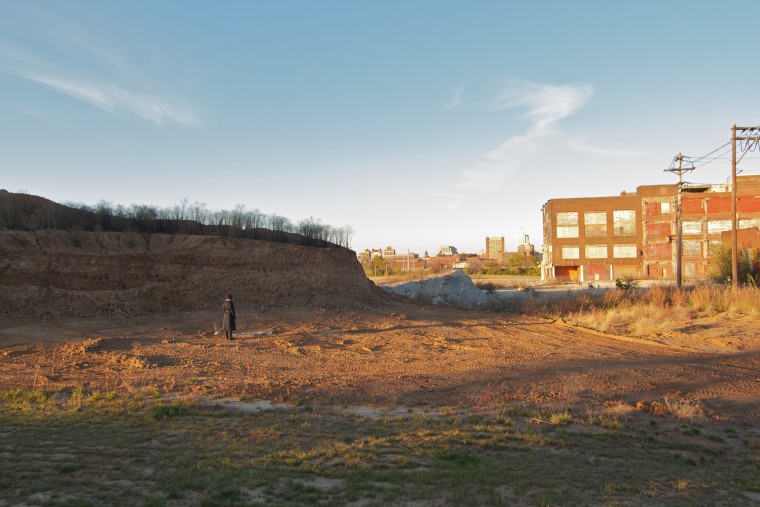A broken hill confronts an abandoned warehouse. Exposed geological strata, softened by rainfall, mirror the red brick façade and white, boarded windows.
In “The City & The City: Mill Creek Valley” (2015) artist Mariam Ghani presents a vision of St. Louis that is raw and powerful but also achingly, elegiacally beautiful.

The image is part of “The City & The City,” a new series Ghani created while in residence at the Sam Fox School of Design & Visual Arts at Washington University in St. Louis.
At 6:30 p.m. Tuesday, April 7, Ghani — the 2014-15 Henry L. and Natalie E. Freund Teaching Fellow — will discuss her work at the Saint Louis Art Museum. The talk is free and open to the public.
The event coincides with the opening of “Currents 110: Mariam Ghani.” The exhibition features “The City & The City” as well as “Like Water From a Stone” (2014), a video exploring the mythologies and modern histories surrounding the jagged Norwegian coastline.
We sat down with Ghani to discuss “The City & The City,” post-Ferguson St. Louis and the importance of making space to listen.
“The City & The City” is inspired by China Miéville’s 2010 novel of the same title. Describe the premise.
Two cities are geographically intertwined but so spiritually divided that they became separate countries, despite being physically crosshatched together. Citizens learn from birth to un-see everything and everyone that belongs to the other city. They look away so quickly, it’s like nothing is there.
Your residency has coincided with a period of heightened tensions following the tragic events in Ferguson last August. Did Ferguson influence your approach?
Of course it did. Ferguson is the subtext for the show. But I’m also interested in making work that goes beyond the immediate moment to look at the deeper structures and longer histories of a place.
Erin Ellen Kelly, the choreographer I’ve been working with for the last nine years, grew up in St. Louis — her grandparents lived in (the neighborhood known as) Dogtown. That’s part of why I applied for the fellowship. I knew that we could make something interesting here. One constant in our collaborations is that they’re always about places and spatial politics. In St. Louis, you can’t really talk about spatial politics without talking about all these other things as well.
So I think “The City & The City” is the kind of project we were always going to make. Making it right now, things just became more acute.

“The City & The City” centers on a narrative video — a sort of murder mystery — that was shot in locations around St. Louis. But it also includes a sound installation and a series of still photographs. How do those three elements work together?
Each part of the show functions a little differently, but each part also helps you to read the other parts.
The video uses ideas and plot elements from Miéville’s book as a conceptual framework that we map onto real places and real histories in St. Louis. The stills show some of those locations — Mill Creek Valley, the Cotton Belt Freight Depot, the former Pruitt-Igoe site and the deconsecrated church St. Liborius — but with the element of fiction removed. The places are themselves again, grounded in reality.
For the sound installation, I invited people from all over St. Louis — different ages, different races, different genders, different classes — to perform an open-ended script, which sparked all sorts of stories about how we relate to public space.
That’s an elegant structure. It allows you to experience and react to the city, but also for the city to speak back to you.
I think artists should always make space to listen. This is not necessarily what artists are taught to do, and expressing oneself is of course also valuable. But to be present for someone else, to listen and to allow them to speak — that can be an intense, and even exhausting, experience.
For the sound piece, did you learn anything that really surprised you?
I don’t know. I’m still absorbing everything that was said. It was more about just being in the room and giving people the space to speak.
But there were contradictions. … A number of people said something like “When a stranger approaches, my first impulse is to smile and say hi.” But others would say, “I smile, but it’s very rare that anyone smiles back at me.”
It just goes to show that everyone’s city is a little different.
We all live in cities within cities. Maybe they overlap, maybe they don’t.
About the lecture and exhibit
“Currents 110: Mariam Ghani” is curated by Eric Lutz, associate curator of prints, drawings and photographs, with Molly Moog, research assistant. The exhibition formally opens Wednesday, April 8, and remains on view through Sunday, July 12.
For more information, visit slam.org.

